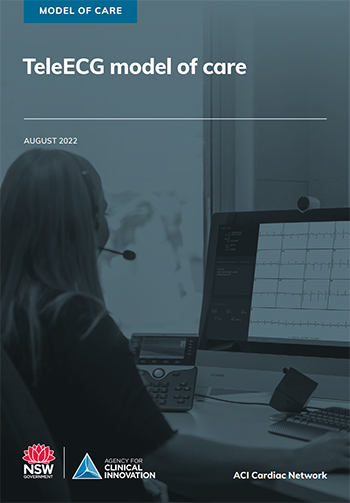Published: August 2022. Next review: 2027.
The NSW TeleECG model of care links specialist nurses with staff in small rural hospitals, to support them to provide care for patients with suspected acute coronary syndrome.
The specialist nurse can help guide the staff from the rural hospital on the appropriate clinical pathway to use for that patient, using a range of virtual care technologies.
The model complements and supports the existing State cardiac reperfusion strategy and Pathway for acute coronary syndrome assessment.
At a glance
- The teleECG service provides decision support for rural emergency department (ED) clinicians in managing patients with possible acute coronary syndrome.
- TeleECG is an evidence-based strategy that supports improved diagnosis and treatment of myocardial infarction in rural NSW.
- Automated download of electrocardiogram (ECG) and troponin results provide real time notification and remote review of images to the TeleECG hub.
- TeleECG provides a safety net that complements established pathways and comprehensive assessment performed in the rural ED.
ECG and troponin automatically upload on acquistion. The ECG generates notification to the TeleECG nurse via a worklist.
This removes the requirement for rural ED clinicians to opt in or activate referral to TeleECG.
TeleECG nurse contacts the rural ED team to provide pathway guided decision support based on assessment of ECG and troponin.
TeleECG nursing staff contact the rural ED directly by phone if any abnormal findings and document discussion in medical record.
Normal findings are communicated via a documentation tool to minimise disruption to rural ED workload.
The appropriate management pathway initiated by rural ED staff based on decision support from TeleECG and local assessment. The management pathway includes:
- State cardiac reperfusion strategy for ST-elevation myocardial infarction (STEMI)
- Admission and transfer for angiography and specialist care for non-STEMI and unstable angina pectoris
- Assessment for other causes and low risk acute coronary syndrome assessment as per Pathway for acute coronary syndrome assessment for no evidence of high risk features.
Background
STEMI is a time-critical, life-threatening, medical emergency. It is essential to rapidly diagnose STEMI and restore blood flow to the heart to reduce the risk of heart failure or death.
Prompt recognition and evidence-based management of non-STEMI and unstable angina pectoris, reduces the risk of an adverse cardiac event.
People living in regional and rural areas have a high burden of cardiovascular disease. However, they may have limited access to specialist emergency care.
The document refers to a two-phase implementation approach. While the model was piloted and considered valid following phase 1, it is not currently being implemented across NSW Health.
